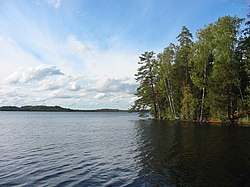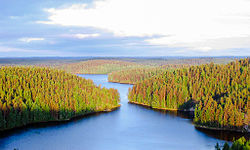| Part of a series on the |
| Culture of Finland |
|---|
 |
| People |
| Languages |
| Mythology and folklore |
| Cuisine |
| Festivals |
| Religion |
| Literature |
| Music |
There are 41 national parks in Finland. They are all managed by Metsähallitus. The national parks cover a total area of 9,892 square kilometres (3,819 sq mi) – 2.7% of Finland's total land area.
Contents
A total of 3.2 million people visited the parks in 2018. [1] During the COVID-19 pandemic, the number of national park visitors strongly increased, with a total of 4.0 million people visiting the parks in 2021. In 2024 the visitor numbers had fallen back to a level of 3.6 million. [2]
Approximately 7.4 million visits were made to state protected areas managed by Metsähallitus in 2024. In addition to national parks, the figure includes state hiking areas and other protected areas that are significant for recreational use. [3]









































